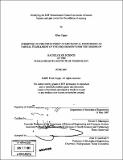Modifying the MIT Sensorimotor Control Lab model of human balance and gait control for the addition of running
Author(s)
Cappo, Ellen (Ellen Angeline)
DownloadFull printable version (1.238Mb)
Alternative title
Modifying the Massachusetts Institute of Technology Sensorimotor Control Lab model of human balance and gait control for the addition of running
Other Contributors
Massachusetts Institute of Technology. Dept. of Mechanical Engineering.
Advisor
Steven G. Massaquoi.
Terms of use
Metadata
Show full item recordAbstract
This research continues the work begun by Sungho Jo and Steve G. Massaquoi on modeling human walking and upright balance. The model of human neurological control of balance and gait generation put forward by Jo and Massaquoi in "A model ofcerebrocerebello-spoinomuscular interaction in the sagittal control of human walking" and executed in MATLAB Simulink/SimMechanics. This model has been used to determine the feed-forward command sequences for the generation of walking and running gaits. Furthermore, two feedback circuits controlling the center of mass relative to the swing leg and the composted leg angle of the simulated model were added. These provide a basis for a wider control of disturbances in order to implement running. This work helps forward the long-term goals of the MIT Sensorimotor Control Group--creating a control model of the neurological circuitry responsible for governing human balance and locomotion and testing that model by using it to control a bipedal robot. The results of this research help to prove the validity of the cerebrocerebello-spinomuscular control model developed by Jo and Massaquoi and point positively towards the introduction of the running of the control model on a physical robot.
Description
Thesis (S.B.)--Massachusetts Institute of Technology, Dept. of Mechanical Engineering, 2007. Includes bibliographical references (leaf 16).
Date issued
2007Department
Massachusetts Institute of Technology. Department of Mechanical EngineeringPublisher
Massachusetts Institute of Technology
Keywords
Mechanical Engineering.